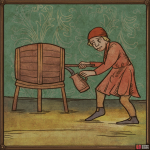Text
For a long time, anyone who wished could brew beer. It was only in the 13th century that brewing gradually came to be regulated. The rules stated that beer could only be brewed and sold by a full-fledged citizen who owned a house within the town walls. The right to brew closely relates to the ‘one-mile right’, which dictated that none but citizens of a town were allowed to conduct ‘urban’ trades within a one mile radius of the city.
The overall process was supervised by the master brewer, the making of the malt and beer was dealt with by the maltster and a brewer handled the fermentation and brewing. In domestic breweries, all these jobs would be done by one man.
The shelf life of beer depended on whether the finished brew was filtered or not. Yeast remained in the brew, as well as acetic or lactic bacteria, contaminating it. ![]() Beer then, quite unlike today, resembled porridge, and was very nutritious (hence known as ‘liquid bread’). It had to be drunk through a straw to filter out foreign matter. Only later was beer filtered to become the classic liquid we think of today.
Beer then, quite unlike today, resembled porridge, and was very nutritious (hence known as ‘liquid bread’). It had to be drunk through a straw to filter out foreign matter. Only later was beer filtered to become the classic liquid we think of today.
St. Wenceslas was the patron saint of maltsters in Bohemia, while the legendary Gambrinus, though not a saint, was regarded as the patron of brewing. The Bohemian brewing tradition thrives to this day and Czech beer is amongst the best in the world.


No Comments